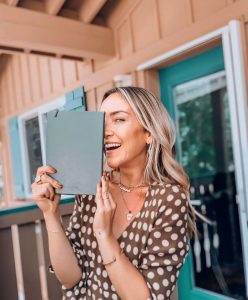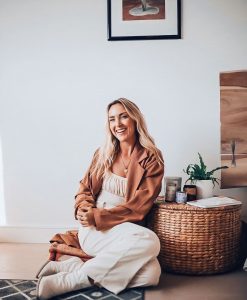Rachel Havekost is the bestselling author of “Where the River Flows: A Memoir of Loss, Love, and Life With an Eating Disorder.” She writes weekly on her Substack, “The Messy Middle,” where she shares honest stories of life inside and outside of mental illness, and what it looks like to radically show up human–mess and all. She aims to facilitate a new age of wellness that is rooted in empowered education rather than profit from pain, and hopes to carve out spaces online and offline where folks feel seen, understood, and represented.

- Can you tell us about your journey with mental illness and how it has influenced your writing?
I was diagnosed with Anorexia when I was 15–but at that time mental health was incredibly stigmatized and nobody was talking about eating disorders. I remember spending a lot of time online (there was no social media then, only Myspace and Livejournal type forums) looking for some way to understand what I was going through and stop it. All I found were Pro-Anorexia websites, which told me I wasn’t a good enough Anorexic if I wanted to stop losing weight. For almost 8 years I dealt with my eating disorder alone, and in that time experienced depression, anxiety, and eventually attempted suicide. I really thought I was the only person in the world experiencing my thoughts and behaviors, and I felt like a disgusting, worthless failure. Years later my boyfriend (who later became my now ex-husband) encouraged me to seek treatment. Being in group therapy and hearing other stories showed me I wasn’t the only person thinking and feeling what I did, and it gave me hope that change was possible. It inspired me to start sharing my story more openly in hopes of helping others feel less alone.
- How do you balance vulnerability and privacy when sharing personal stories online?
This is recently an important boundary I’m practicing. There was definitely an evolution and non-linear path to get here, and I wouldn’t say I’m done navigating this balance. When I started writing, I was open, but not really open. I left out details and was somewhat vague in discussions of my eating disorder or depression–I would talk about having mental illness or the solutions I’d found to help manage symptoms, but didn’t dive into what I considered the ugly, dark side of my brain. As I gained more trust with my readers, I felt safe enough to be more open, and I was. The more freely I shared, the more people related. This meant I was also getting frequent DMs or emails asking for help, which I’m not licensed to do. I had to start setting boundaries around what my writing was and wasn’t, and also remind people that I’m a real person (and there is only one of me). I started going off social media on weekends and allowing myself to have my own time, free from posting/writing/needing my life to be in service of content. As for folks who did DM me, I often read stories of people who were suicidal or dealing with trauma. While I didn’t have answers, I related to the aloneness and shame. I made a conscious decision to be more open about the thoughts in my head, the things I’ve done, and the uncertainty I often feel, knowing it would expose me as “imperfect” in a space that often expects us to show our ideal selves. I hoped that by showing up messy I could empower other people to embrace their humanness and settle more into what it means to be alive, rather than striving to change, fix, or alter themselves to fit some ridiculous standard. Nowadays, I long for more privacy. That’s partly because I feel some burnout from always being in my own head searching for stories. So I’m interested in finding ways to write and help others without needing to be a character in the plot.

- Your writing often challenges traditional notions of wellness. Can you expand on what that means to you?
When I was first diagnosed with an Eating Disorder it was relieving. For the first time, I had a name for all the symptoms I was experiencing. A box to put my scary thoughts into. A place outside of myself that could hold the part of me I longed to kill, but felt so deeply attached to. Naming my illness was empowering for years. It allowed me to witness my depression, anxiety, and trauma as external. This reduced a lot of shame and created space for Rachel to come through and challenge, support, and love on these illnesses so they could heal. After attending graduate school for Mental Health Counseling, I learned more in-depth about diagnoses and that the DSM (that’s the book of mental disorders, their symptoms, and criteria for diagnosis by a clinician) was made by the American Psychiatric Association. Diagnoses were created so psychiatrists could prescribe medication. I felt uncomfortable knowing that the pain people experienced was being categorized in order to make a profit. (aside: I believe in informed consent and that every individual has the right to choose medication. There is nothing wrong with doing what is best for you, and you get to decide what that looks like). I personally prefer not to take psychiatric medication. This is a personal choice I made because I know myself well enough that if I am taking a medication I rely on it to exclusively solve my symptoms and I stop taking responsibility for anything else that might help me get well (I’m not assuming others do this or would, this is just my experience). I also learned about the dozens of therapeutic approaches that therapists use with clients–there isn’t just one way to conceptualize “disease” or mental illness. Yes, we can look at it as a clinical, medical, concrete illness that has concrete steps to resolve like a physical illness. Yes, we can look at it like a dysregulated nervous system that has been overloaded with stress in a highly pressurized oppressive society that demands we perform and never rest. Yes, we can look at it as existential dread of our inevitable deaths, and that every act to control, change, or leave a legacy for our life is an attempt to stop our ultimate fate. Yes, we can look at it as wounds created in childhood that left us with trauma, attachment wounds, or limiting beliefs. Yes yes yes. There isn’t a right way to understand our mental health because mental health is inherently complex: it includes our cognitive, emotional, social, biological, cultural, historical, and generational health. So now, I look at myself as a human being. Someone who has had life experiences in this modern world that have shaped my views and beliefs. Someone who wants love and fears a life alone. Someone who needs to survive and is sometimes scared of how to do that. Someone who will continue to meet grief, loss, and death in her life and handle it to the best of her ability. Someone who over time, continues to learn and evolve and find new ways to handle life’s inevitable stressors. That is what wellness means to me.
- Your memoir has resonated with many readers. Were you surprised by the response?
Honestly, yes. My mission was to make one person feel less alone. I didn’t imagine it would help more than a handful, and I certainly didn’t expect so many people to say they related so deeply with so much of the book. I’m deeply honored and humbled everytime someone says my book made them feel less alone.

- Can you speak to the importance of representation in media and literature for those with mental illness?
Yesterday I was reading an article about transgender community belongingness as it relates to well-being, and the researchers talked about the importance of identity-based communities to allow members of marginalized groups to experience a sense of belonging (Barr et al., 2016). Belonging is a long-standing topic in psychology research. It is implicated in our survival, and ultimately our wellness. We are inherently social creatures, and to belong is to have a safe network of others to help us survive (Barr e al, 2016). When I was growing up, there was no representation of mental illness in media, which exacerbated shame and stigma. Folks that did go to therapy (at least when I was growing up) didn’t talk about it, and if they did, the topic was avoided and often met with judgments or assumptions of that person being “unstable.” Having a mental illness is still stigmatized and I am STILL scared to share that I struggle with an eating disorder when I meet new people (also, you do not have to share anything with anyone unless you feel comfortable and want to). I want to, because it’s important to me that friends or partners are aware of my history and understand who I am fully. Still, I ask myself if they’ll think I’m hard to deal with, if they’ll assume I have constant breakdowns, if they’ll think I’m unreliable or volatile…I project dozens of my own insecurities and fear of being rejected, judged, or looked down on. Visibility is important because it normalizes an experience that is incredibly common. I want to be careful here and remind folks that normalizing something should not minimize it–just because something is common does not mean it’s normal. While humans are an incredibly adaptable species, we haven’t developed superhuman powers to be unphased by traumatic events, tolerate long periods of stress, cope with oppression, or thrive in our current cultural climate. Representation should reduce shame, but not at the expense of minimizzing the severity, intensity, or pain of the people experiencing mental illness. Hopefully, more representation can also serve to educate folks without mental illness, so they can better understand how to support, love, and respect individuals who do (and let them focus on getting well).
Reference:
Barr, S. M., Budge, S. L., & Adelson, J. L. (2016). Transgender community belongingness as a mediator between strength of transgender identity and well-being. Journal of Counseling Psychology, 63(1), 87–97. https://doi.org/10.1037/cou0000127

- How do you hope to create spaces both online and offline where individuals can feel seen and understood?
Because I started writing during the pandemic I never found a groove with offline spaces, though it’s something I’m considering in the future (writing retreats, for example). Online, I try to write in various places to reach different kinds of consumers, because I know people learn in myriad ways. I have an instagram where I connect with people through videos and short captions, which allows visual folks and readers to get short stories and inspiration. My blog is where I do more didactic writing and offer tips, resources, and journaling prompts for people who want to know themselves a little more intimately. In the past I’ve hosted live Instagram or Tiktoks to simply have discourse and a safe space to chat (though I’ve eased off social media this year for my own mental health and haven’t gone live in a while). I also write longer-form stories on my Substack for people who long to get away from social media and are seeking slower, longform content, which is now my primary space to connect with people.
- Your Substack, “The Messy Middle,” has gained a large following. Can you share your approach to creating engaging content?
This is still an experiment. I launched “The Messy Middle” in January, and I am still learning the ins and outs of Substack, what works, what my readers like, and what they don’t. While it’s a similar format to blogging, it’s a much more alive platform, in that it also allows me to connect with readers in a chat space, with notes (kind of like tweets), using polls in my posts, comments, and–if I feel really brave– podcasts. My approach is to have seasonal themes which allow me to stay within some kind of contained bubble (otherwise I roam too free in my subjects) while still giving me room to be creative. This season is about “accepting parts of self,” so readers know each newsletter will be loosely tethered to the idea of self-acceptance. My hope is that this provides readers with enough consistency to feel safe while allowing me creative license to take them on a journey. Ultimately, my goal is to write with more humor, levity, and play in my Substack. Much of my writing in the last few years has been dark and heavy. While I believe that work was needed, I am interested in bringing comedy, satire, and wit into my stories. “The Messy Middle” is, indeed, messy.

- In your opinion, what role should education play in promoting mental health and wellness?
I think education should primarily be left to educators. I used to play a much heavier role in educating my audience, but as I got further away from my schooling and wasn’t physically in the field, it didn’t feel ethical to me to share things I’d learned in school years prior. I also no longer had access to peer-reviewed journals or scholarly articles, which meant if I was continuing my own education to source my information, it was coming from websites that aren’t rooted in research. There is a lot of misinformation online, especially on social media where anyone can decide to teach a subject. It is difficult as an everyday consumer to discern who is teaching from a place of valid and reliable sources vs. regurgitating other ideas or prophesizing personal ideals. There is the added dimension of using knowledge as a funnel to sell, which unfortunately is fairly mainstream now. If I do share education with my audience now, I am clear about where it comes from (even if that’s my own experience). I do believe that mental health should be embedded in our actual educational model. I would love to see a curriculum from pre-school through college where students are taught basic self-regulatory skills, social skills, boundaries, coping with stress, appraising cognitive distortions, making meaning in life, letting go, grieving…that, to me, would be the ideal role education played in promoting mental health.
- What advice would you give to someone struggling with their mental health?
Talk to someone. Call a friend. Text a family member. Write it on paper and share it with someone you trust. Yes, at some point, therapy would help. Yes, at some point, journaling would help. Yes, all the tools and tips and breathing would help. But first and foremost, you have to know you’re not alone. Life is not meant to be lived alone. We are social beings and we require connection. Oftentimes we are struggling with our mental health because we feel alone, or because we are alone. Having someone on our side or team while we face the incredibly difficult path of getting better creates a sense of comfort, safety, and support. So my advice would be, if it’s accessible, tell a loved one what you’re experiencing. Tell them you’d like to get help, and that it would mean so much if they were on your mental health team. Work together to make a plan, and know you are brave as hell for reaching out.

- Can you speak to the impact of storytelling in reducing stigma surrounding mental illness?
Stories shift how we see our life circumstances.
11. Have you ever watched a movie and suddenly been inspired to take the same action as the main character? Read a book and felt more hopeful about what life could be?
Seen a play and felt a catharsis by sharing tears with someone on stage? Stories transport us out of our own predicament and into the predicament of the characters in the plot. They inherently help us separate from our internal dialogue for just long enough that we can imagine new possibilities. Stories take us through change and evolution–most stories have beginnings, where we witness some of our own longing or despair; middles, where we witness struggle and obstacles we may fear in our own future; and endings, where hope and resolution live. While I believe these kinds of stories are powerful, I don’t think they always alleviate the pain that folks with mental illness feel. For us, life feels like a constant beginning and middle, but neverending. We long for one day to be fully pain-free, but it seems to never come. Or if it does, it isn’t long-lasting. Mainstream storytelling is misleading in this way and can create less hope, less optimism, and more shame. My goal is to tell stories that don’t necessarily have endings. Stories that start in the middle and end at the beginning. Stories that represent what it means to keep going, not finish. My hope is that with stories like these, people start to experience less shame in their own messy middles. That they start to feel inspired by living life in the uncertain. That the catharsis is in knowing there is nothing wrong with them, and they are simply beautiful, wild, and very much alive.
